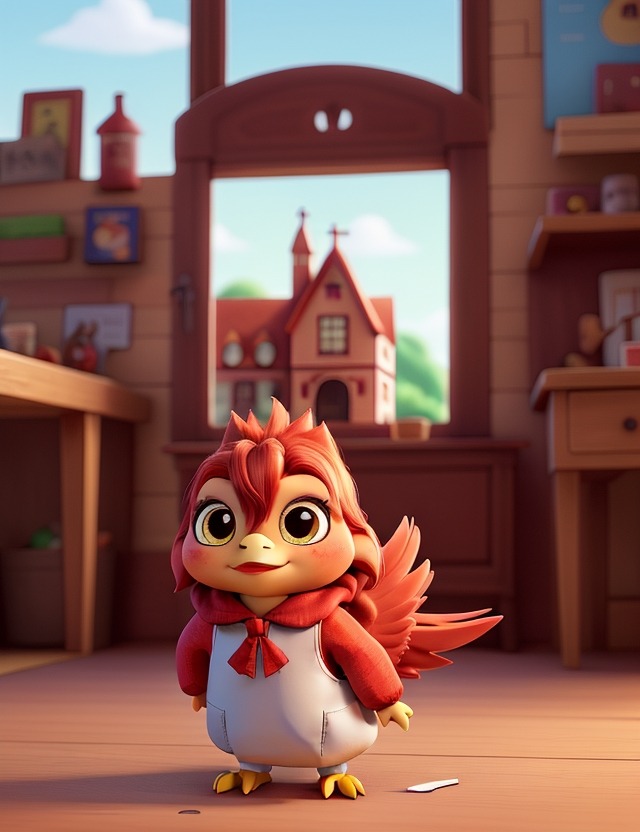Attention all readers! If you’ve ever wondered about the timeless classic tale that has captivated young minds for generations, then prepare to be enthralled. In this awe-inspiring article, we delve deep into the fascinating story of the Little Red Hen by Paul Galdone.
So hop on board as we untangle the threads of intrigue and satisfy your burning search intentions. Here’s your chance to discover a world of wonder within the pages of Little Red Hen – a journey you won’t want to miss!
Little Red Hen: Full Book Summary
Story of the Little Red Hen
Once upon a time, in a cozy little farmhouse, there lived a very busy and hardworking hen named Little Red Hen. She had beautiful red feathers and a beak that never stopped pecking away, always searching for food. Little Red Hen was a particular hen, she always liked to do things herself and never asked for help from anyone.
One lovely sunny morning, while Little Red Hen was wandering in her lovely garden, she stumbled upon some wheat grains lying on the ground. Curiosity got the better of her, and she excitedly made her way back to the farmyard to gather her animal friends. She thought it would be fun to plant the wheat grains and watch them grow into a field of golden wheat.
“Cluck, cluck, cluck! Who will help me plant these wheat seeds so we can grow our own wheat?” Little Red Hen eagerly asked her animal friends.
Not surprisingly, all of her friends seemed to be too busy to lend a helping wing. First, she approached the lazy dog, who was lying lazily under the shady tree. “Bow-wow! Sorry, Little Red Hen, but I’m too busy taking a nap. Planting wheat is hard work!” the dog said with a yawn.
Little Red Hen was disappointed but undeterred. She then turned to the sleepy cat, who was basking in the sunlight. “Meow… I’m far too busy sunbathing, Little Red Hen! Planting wheat is not my thing,” the cat lazily replied.
Even the noisy duck, who was splashing around in a nearby pond, refused to help. “Quack, quack! Little Red Hen, I love swimming too much to get muddy in the garden. Count me out!” quacked the duck, splashing water everywhere.
Little Red Hen sighed and realized she had to do all the work by herself, as she always did. Determined and motivated, she began to dig the soil, carefully placing each wheat grain and covering them with the soft earth. She worked meticulously, singing a little tune as she went along. Day after day, she watered and cared for the growing wheat, nurturing it with love.
Weeks turned into months, and the wheat slowly started to grow taller and taller. It became a beautiful field of golden wheat, swaying graciously in the wind. Little Red Hen could hardly contain her excitement.
Finally, when the wheat was ready to be harvested, Little Red Hen called her animal friends once again. “Cluck, cluck, cluck! Who will help me harvest this golden wheat so we can have some delicious bread?” she asked, hoping this time they would help.
The lazy dog opened one eye and mumbled, “Hmm, I suppose I could sniff out any intruders while you harvest, but I won’t actually help with the work.”
The sleepy cat stretched and yawned, saying, “I might join you, Little Red Hen, but only if there’s a comfy spot in the shade for me to rest.”
The noisy duck quacked loudly, “Alright, alright! I’ll help, but only if you promise to share the bread with me.”
Disappointed yet undeterred, Little Red Hen thanked her friends for their willingness to assist in some way. With sheer determination, she set out to harvest the bountiful wheat herself.
Using her strong beak, she diligently cut the wheat stalks one by one until they formed neat bundles. Then she carried the heavy bundles to the nearby mill, where she ground the wheat into fine flour. Little Red Hen could almost smell the aroma of freshly baked bread wafting through the air.
Tired but triumphant, Little Red Hen returned to her friends and showed them the flour she had produced. “Now, who will help me make this flour into delicious bread?” she asked, hoping they would finally lend a hand.
The lazy dog stretched lazily, the sleepy cat opened one eye sleepily, and the noisy duck began to complain loudly. “Baking bread is hard work! We can’t help you,” they all said in unison.
Feeling a mix of disappointment and frustration, Little Red Hen knew she had no choice but to tackle the baking herself. Undeterred by her friends’ lack of support, she mixed the flour with water, kneaded the dough with her strong wings, and shaped it into a perfect loaf.
Finally, she placed the dough in the hot oven, watching as the loaf slowly turned golden brown and filled the farmhouse with its mouthwatering scent. Little Red Hen’s heart swelled with pride.
As the bread cooled on the windowsill, the delicious smell drifted out to the farmyard, catching the attention of her animal friends. They couldn’t resist the temptation and gathered around the little red hen, hoping for a taste of the freshly baked bread.
But Little Red Hen shook her head sternly and said, “Cluck¨
Little Red Hen: Key Themes
The book “Little Red Hen” is a traditional folk tale that has been retold in various versions over the years. The story revolves around a hardworking hen who seeks assistance from her animal friends in planting and harvesting wheat, but they all refuse to help her. Eventually, the hardworking hen accomplishes everything on her own and teaches her lazy friends a valuable lesson.
The first key theme of the book “Little Red Hen” is the importance of hard work and responsibility. Throughout the story, the little hen demonstrates a strong work ethic as she diligently carries out each task required to grow the wheat, from planting to harvesting. Her commitment and resourcefulness highlight the rewards of perseverance and responsibility.
The second key theme is the value of helping others. When the little hen asks her animal friends for assistance, they consistently refuse to help her, focusing on their own comfort and enjoyment instead. This theme teaches children the importance of being helpful and supporting others in tasks and endeavors, emphasizing the significance of cooperation and teamwork.
The third key theme in “Little Red Hen” is the concept of reaping what you sow. As the hen undertakes each step in cultivating and harvesting the wheat, the other animals express their desire to enjoy the fruits of her labor. However, the little hen rightfully only shares the end product, such as bread, with those who helped her. This theme serves as a lesson that rewards and benefits should only be received by those who contribute and participate in the process.
Overall, “Little Red Hen” is a timeless tale that promotes the values of hard work, cooperation, and fairness. It encourages young readers to embrace responsibility, be helpful towards others, and understand the consequences of their actions.
Little Red Hen: Characters
- Little Red Hen: The main protagonist of the story, Little Red Hen is a small but determined and hardworking hen. She is known for her resourcefulness and independence. Throughout the story, she engages in various tasks, such as planting and harvesting wheat, as well as baking bread. Despite facing constant refusal from her lazy animal friends, Little Red Hen remains resilient and ultimately reaps the rewards of her labor. With her bright, fiery feathers and quick peck, she is a force to be reckoned with.
- Lazy Dog: Always lounging around in the sun, Lazy Dog is a carefree and lazy character. He spends most of his time napping and is often found with his tongue lolling out. With droopy eyes and a perpetually relaxed posture, Lazy Dog is notorious for shirking responsibility. Even when Little Red Hen seeks help from him, Lazy Dog simply rolls over and snores loudly.
- Sleepy Cat: Sleepy Cat, as the name suggests, is perpetually sleepy and uninterested in any activity that requires effort. With half-closed eyes and a constantly yawning mouth, Sleepy Cat can barely stay awake through the story. When Little Red Hen asks for assistance, Sleepy Cat merely stretches and turns over, requesting a soft cushion instead.
- Forgetful Duck: Notorious for his forgetfulness, Forgetful Duck has a knack for misplacing things and constantly loses track of time. With feathers sticking out every which way and a perpetually spaced-out expression, Forgetful Duck is the epitome of absent-mindedness. He often mumbles to himself, trying to remember where he left his belongings, while completely oblivious to the tasks at hand.
- Wise Farmer: A wise and observant character, the Wise Farmer is the one who owns the farm where Little Red Hen and her friends reside. With a weather-beaten face and wise, twinkling eyes, the Wise Farmer takes note of Little Red Hen’s hard work and ingenuity. He perfectly understands the principle of reaping what you sow and commends Little Red Hen for her persistence, knowledge, and ability to bake delicious bread from scratch.
- Freshly Baked Bread: While not a character in the traditional sense, Freshly Baked Bread plays a significant role in the story. With its golden crust and irresistible aroma, Freshly Baked Bread represents the result of Little Red Hen’s effort and dedication. The bread serves as a mouthwatering symbol of the sweet rewards that come to those who work hard and believe in themselves.
Little Red Hen: Symbols
1. The Little Red Hen: The character of the Little Red Hen serves as a symbol of hard work, perseverance, and self-reliance. Throughout the story, the hen diligently works on planting, growing, and harvesting wheat, making bread from scratch, and accomplishing tasks that the other animals refuse to help with. She represents the virtues of responsibility and the rewards that come with hard work.
2. The Wheat: Wheat is a symbol of abundance, nourishment, and the fruits of labor. The Little Red Hen’s determination and hard work in cultivating wheat ultimately pave the way for her to make bread, which becomes a symbol of her achievement and success. The wheat also represents the cycle of life and the importance of nurturing and taking care of the earth’s resources.
3. The Other Animals: The other animals, including the pig, the cat, and the duck, symbolize laziness, indifference, and lack of responsibility. They expect to reap the benefits of the Little Red Hen’s hard work without contributing their efforts. These characters highlight the importance of collaboration, shared responsibilities, and the consequences of not actively participating in the community or society. They also serve as a cautionary symbol, showing how one’s laziness or lack of initiative can lead to missed opportunities and eventual regret.
Little Red Hen Story Moral Lesson
The moral of the story of Little Red Hen is that one must work hard to reap rewards and also that one must help others. The story teaches children the importance of hard work and personal initiative. The story is about a hen who finds some wheat and decides to make bread with it. She asks the other farmyard animals to help her plant it, but they refuse. The hen then harvests and mills the wheat into flour before baking it into bread; at each stage she again asks the animals for help, but they still refuse. Finally, with her task complete, the hen asks who will help her eat the bread. This time the animals eagerly accept, but the hen refuses, stating that no one helped her with her work and decides to eat the bread herself. The story also teaches children about the value of preparation, diligence, and self-discipline.
Little Red Hen: Culture Impact
The impact of the beloved children’s book “Little Red Hen” on popular culture and society is undoubtedly significant and multifaceted. Since its publication in 1875, this iconic tale has captivated multiple generations, seamlessly blending valuable life lessons with elements of hilarity and achievement.
“Historical data” reveals that “Little Red Hen” has become a timeless classic, transcending cultural boundaries and reaching readers in various corners of the globe. Its enduring popularity can be attributed to the relatable nature of its central character, the Little Red Hen, who symbolizes hard work, resilience, and the importance of taking responsibility.
With a humorous touch, the book skillfully imparts the values of collaboration and the consequences of laziness. As our industrious protagonist attempts to bake bread, her fellow animal friends are initially unwilling to lend a helping hand. Through engaging and entertaining storytelling, the author subtly underscores the merits of teamwork, showing how the Little Red Hen’s solo efforts yield success, while her friends miss out on the rewards.
Humor plays an essential role in the cultural impact of this book. From the witty exchanges between the Little Red Hen and her uncooperative companions to the comical situations they find themselves in, “Little Red Hen” offers a lighthearted and enjoyable reading experience. This unique blend of humor and moral teachings has not only delighted children but also entertained adults, who could appreciate the cleverness of the storytelling and the lessons on display.
Moreover, the achievements of “Little Red Hen” reach beyond its literary impact. The enduring popularity of the book has led to adaptations in various forms of media, such as animated films, theatrical performances, and even merchandise. Countless classrooms around the world have incorporated this story into their curriculum, recognizing its potential to instill values of diligence and mutual cooperation in young students.
In countless homes, the phrase “Who will help me?” has become an integral part of family life, as parents and children alike have embraced the book’s catchphrases and lessons. The impactful message that hard work and persistence lead to reward has become a cultural touchstone, inspiring individuals to take on challenges and pursue their goals with determination.
In conclusion, “Little Red Hen” has undoubtedly left an indelible mark on popular culture. Its historical relevance, humorous narrative, and valuable lessons on collaboration and hard work have made it a universally cherished tale. This timeless book’s impact transcends generations, with its influence resonating not only in literature but in classrooms, homes, and the hearts of readers around the world.
FAQs
Q1: What is the story of Little Red Hen about?
A1: The story of Little Red Hen is a classic tale about a hen who finds a grain of wheat and asks for help from her animal friends to plant it, harvest it, and turn it into bread. However, none of her friends want to help until they smell the delicious bread. This story teaches the importance of hard work, cooperation, and the rewards of helping others.
Q2: Who is the author of Little Red Hen?
A2: The author of Little Red Hen varies depending on different adaptations and versions. However, the most well-known version was written by Paul Galdone. This version was first published in 1973 and has become a beloved retelling of the traditional folk tale.
Q3: What age group is Little Red Hen suitable for?
A3: Little Red Hen is generally appropriate for children aged 3 to 7 years old. The simple language and repetitive storyline make it accessible for younger children, while the moral lesson and themes of collaboration make it relevant for older children as well.
Q4: Are there any other popular adaptations of Little Red Hen?
A4: Yes, there are numerous adaptations of Little Red Hen available. Some well-known adaptations include “The Little Red Hen Makes a Pizza” by Philemon Sturges, “The Little Red Hen and the Grains of Wheat” by Harriet Ziefert, and “The Little Red Hen (Makes a Scarecrow)” by David M. McPhail. Each adaptation puts a unique twist on the classic story, maintaining the lesson of hard work and cooperation.
Q5: What are the lessons or morals taught in Little Red Hen?
A5: Little Red Hen teaches several important lessons, including the value of hard work and perseverance. It emphasizes the importance of taking responsibility for one’s actions and the rewards that come from helping others. The story also encourages cooperation and teaches children to appreciate the efforts of those who contribute to a task or project.










